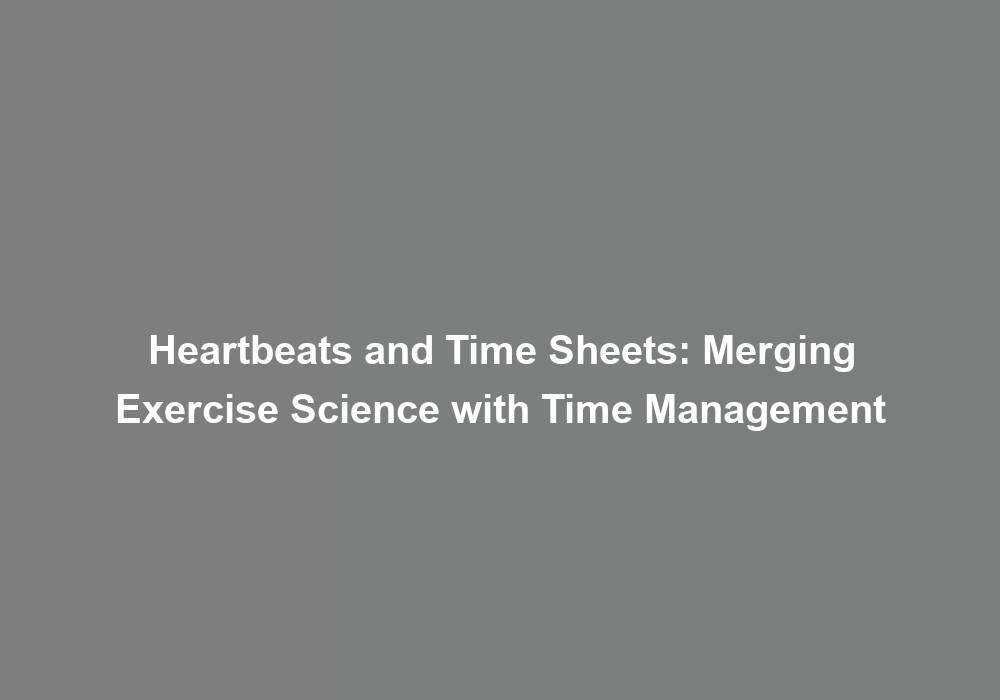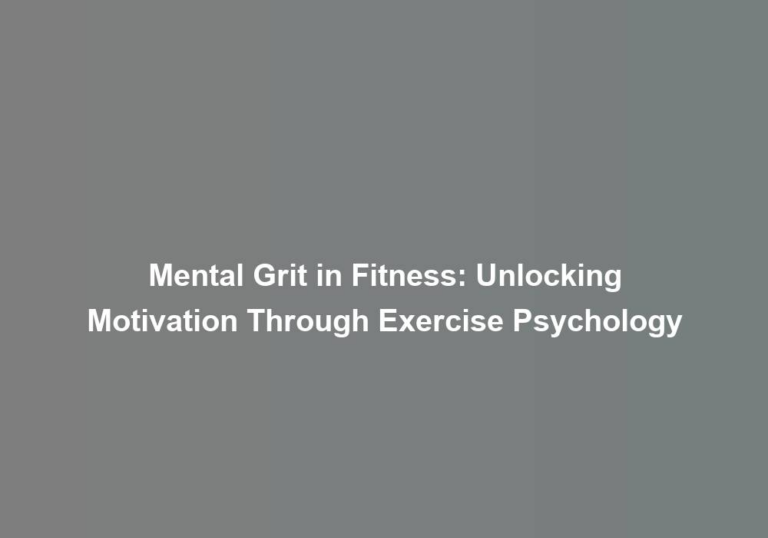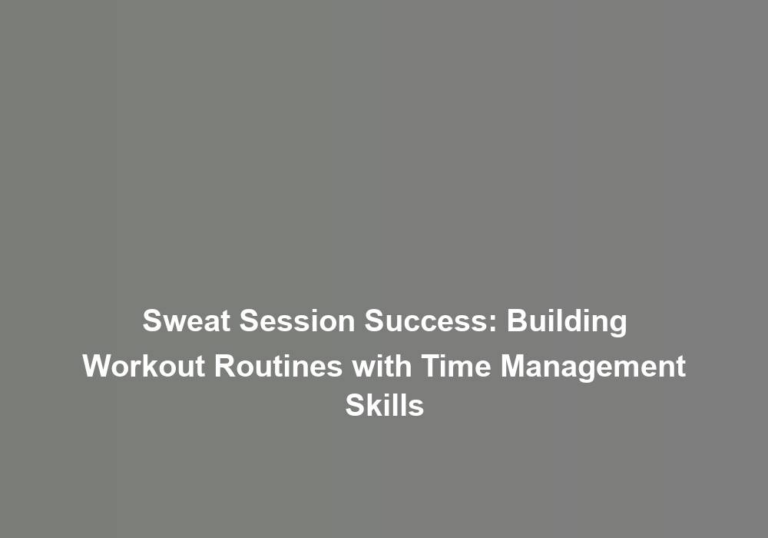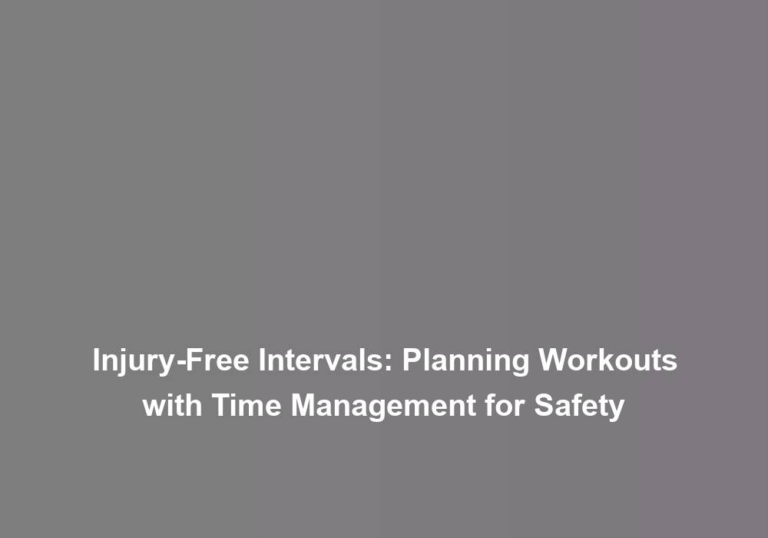Heartbeats and Time Sheets: Merging Exercise Science with Time Management
Imagine your workday as a symphony, with your heartbeats setting the tempo and your time sheets orchestrating the movements. As you navigate through the hectic rhythm of deadlines and meetings, have you ever wondered how to seamlessly integrate exercise science principles with time management strategies to optimize your productivity and well-being? ThereG??s a growing body of research that suggests the correlation between physical activity and enhanced cognitive function, which opens up an intriguing conversation about the potential synergy between exercise science and time management.
Understanding Exercise Science Fundamentals
Understanding Exercise Science Fundamentals involves comprehending the physiological and biomechanical principles underlying human movement and exercise performance. Muscle function is a key component of exercise science, encompassing the intricate interactions between muscles, tendons, and bones to produce movement. The fundamental understanding of muscle function is essential for optimizing exercise performance and preventing injuries. It involves delving into the mechanisms of muscle contractions, the role of different muscle fiber types, and the principles of muscle adaptation to exercise.
Energy expenditure is another crucial aspect of Exercise Science Fundamentals. It pertains to the various ways in which the body utilizes energy during physical activity. Understanding the intricacies of energy expenditure is vital for designing effective exercise programs tailored to individual needs. This encompasses the study of metabolic pathways, oxygen consumption, and the physiological responses to different exercise intensities and durations.
Applying Time Management Principles
To effectively manage your time in the realm of exercise science, it is essential to integrate the fundamental understanding of muscle function and energy expenditure with strategic planning and allocation of resources. One key time management principle that can significantly enhance your productivity is time blocking. This involves setting aside specific blocks of time for different tasks or activities. By allocating dedicated time slots for tasks such as exercise programming, client consultations, and research, you can ensure that each aspect of your work receives the attention it deserves. This not only helps in maintaining focus but also allows for a more systematic approach to managing your workload.
Prioritizing tasks is another crucial aspect of applying time management principles within the context of exercise science. It involves identifying the most critical and time-sensitive activities and ensuring that they receive precedence in your schedule. For instance, if you have a deadline for designing a new training program, prioritizing this task over less urgent activities can help in meeting the deadline without unnecessary stress. Utilizing techniques such as the Eisenhower Matrix, which categorizes tasks based on their urgency and importance, can aid in making informed decisions about task prioritization.
Integrating Physical Activity Into Work Hours
Integrating physical activity into your work hours can enhance overall productivity and well-being, fostering a balanced and active lifestyle in the context of exercise science. Workplace fitness is a growing trend that has been shown to have numerous benefits for both employees and employers. One way to achieve this is through active breaks, which are short periods of physical activity incorporated into the workday.
Studies have demonstrated that taking brief, active breaks during the workday can lead to improved concentration, alertness, and overall job performance. These breaks can range from simple stretches at your desk to short walks around the office. The key is to engage in physical activity that gets your heart rate up and your muscles moving. By doing so, you can combat the negative effects of prolonged sitting and sedentary behavior.
Employers can play a crucial role in promoting workplace fitness by providing opportunities and facilities for physical activity during the work hours. This could include designated areas for stretching or exercising, standing desks, or organizing group fitness activities. Encouraging employees to take active breaks not only benefits their physical health but also contributes to a positive work culture and increased camaraderie among colleagues.
Incorporating physical activity into your work hours is an effective way to prioritize your well-being and productivity. By embracing workplace fitness and integrating active breaks into your daily routine, you can optimize your performance while fostering a sense of belonging in a healthy and supportive work environment.
Maximizing Productivity Through Movement
By incorporating regular movement and physical activity into your work routine, you can significantly enhance your overall productivity and cognitive performance. Workplace workouts and movement breaks have been shown to have a positive impact on cognitive function, mental clarity, and overall well-being. Here are five key ways in which maximizing productivity through movement can benefit you:
- Enhanced Focus: Engaging in short movement breaks throughout the workday can help you maintain focus and concentration, leading to improved task performance and efficiency.
- Stress Reduction: Physical activity has been linked to lower stress levels, making it easier to manage the demands of a busy work schedule and reducing the likelihood of burnout.
- Energy Boost: Taking short movement breaks can help combat the mid-afternoon slump, providing a natural energy boost and reducing the need for stimulants like caffeine.
- Creativity and Problem-Solving: Movement has been shown to enhance creative thinking and problem-solving abilities, making it easier to tackle complex tasks and generate innovative ideas.
- Overall Well-Being: Regular movement breaks can contribute to improved physical health, reducing the risk of sedentary-related health issues and promoting a sense of well-being.
Incorporating workplace workouts and movement breaks into your daily routine can have a profound impact on your productivity and overall work performance. By embracing the benefits of movement, you can create a more dynamic and rewarding work experience while enhancing your cognitive abilities and overall well-being.
Creating a Balanced Lifestyle Through Scheduling
Incorporating structured time management techniques into your daily routine can facilitate the cultivation of a balanced lifestyle, optimizing productivity and well-being. Scheduling strategies play a pivotal role in achieving work-life balance, and adopting the right approach can significantly impact your overall quality of life. One effective strategy is to prioritize tasks based on their importance and urgency. This can be achieved using time management matrices such as the Eisenhower Matrix, which categorizes tasks into four quadrants based on their level of importance and urgency. By allocating time to tasks according to this framework, you can ensure that essential responsibilities are addressed while minimizing time spent on less critical activities.
Another scheduling strategy involves setting realistic and achievable goals within specific timeframes. This approach allows for better time allocation, ensuring that you have dedicated slots for work, exercise, leisure, and relaxation. Moreover, incorporating regular breaks into your schedule can enhance productivity and prevent burnout. The Pomodoro Technique, for instance, encourages work in short, focused intervals followed by brief breaks, promoting sustained concentration and mental agility.
Furthermore, leveraging technology for scheduling and time management can streamline the process and help you stay organized. Utilizing calendar tools and productivity apps can aid in planning and tracking daily activities, ensuring that you make time for both professional commitments and personal well-being. By implementing these scheduling strategies, you can create a balanced lifestyle that harmonizes work and leisure, fostering a sense of fulfillment and contentment.
Conclusion
So, are you ready to revolutionize your workday by incorporating exercise science and time management principles? By merging physical activity with your daily routine, you can enhance productivity, improve overall health, and create a more balanced lifestyle. ItG??s time to ask yourself: how can you optimize your time and energy through strategic scheduling and movement? Take the first step towards maximizing your potential and achieving greater success through the integration of exercise science and time management.







